
Kashmir, a state, unfortunately, more in the news for its problems than its achievements, has a rich history that gets lost amidst the clamour of news and social media. In this post, we take a brief look at this lineage.
As with human history in old civilisations, the story of Kashmir starts from a legend. The story goes that Rishi Kashyap once drained the water from a huge lake that was surrounded by the Himalayas. Once the water was gone, there emerged the world’s largest and most beautiful valley. The esteemed Rishi’s son, Neel, became the first ruler of the region that came to be called over time as Kashmir after the sage. The ascension and rule of Neel were said to be around 10,000 BC as per the Nilamata Purana.
Books such as the Mahabharata mention the Gonand dynasty as rulers of Kashmir. It was supposed to have been followed by the Pandava dynasty, with Harnadeva, a grandson of Arjuna being the first king. There were twenty-three kings in the Pandava dynasty and they extended their rule far beyond the valley. At its height, the Pandava Empire was supposed to have extended from Kanauj (in modern UP) to Gandhara (now Kandahar) in Afghanistan.
The mythology, if nothing else, points to the valley being inhabited by people in ancient times. Archaeological findings of Neolithic, Megalithic and Post-megalithic remains such as the ones at the Burzahom archaeological site attest to this fact.
Factual history shows that Kashmir was a part of the Great Maurya Empire. Under Ashoka, the region was a centre of Buddhism and remains of Buddhist temples and stupas can still be seen to this day. Ashoka also established a city called Srinagari which is said to be the precursor to modern-day Srinagar.

Buddhism remained the primary religion of Kashmir for several centuries. It received significant patronage during the reign of Kushan dynasty. The fourth Buddhist council was held during the reign of the great Kushan king Kanishka – the one without a head. Hiuen Tsang (or Xuanzang) and the lesser known Chinese traveller Ou Kong, both of whom visited Kashmir attest to the strong presence of the religion in the valley.
However, over the years, Buddhism waned as Hinduism became more assertive. The patronage the Vaisnava and Saiva faiths received under the kings of different dynasties, especially from the middle of the 9th century AE, resulted in Hinduism replacing Buddhism across the valley, though it continued to be respected and appreciated.
Strong and stable kingdoms in the latter part of the first millennia and early part of the second saw a rise in artistic and cultural expressions. One of the most noted scholars to emerge was Kalhan, whose Rajtarangni chronicles the history of Kashmir from mythical times to 12th century AE. Some of the prominent kings of this period were Lalitaditya of the Kakrota dynasty and Awantivarman of Utpala dynasty.
Lalitaditya constructed the famous temple of Martand and the city of Parihasapura, which is now an ASI site and a tourist attraction near present day Shadipur. He led successful military campaigns against Tibet as well as empires in modern-day North India. Unlike Lalitaditya, Avantivarman, the founder of the Utpala dynasty, is more popular for his consolidation efforts rather than his conquests. Awantipora, named after the King, is a present day town about 30 km from Srinagar and is famous for its ruins of the Awantipora temple, a tourist site on the way to Pahalgam.
The Muslim rule in Kashmir began around 1339 AE after the Lohara dynasty collapsed. The first Muslim ruler was Rinchana, a Tibetan Buddhist who converted to Islam to secure the support of Muslims for his rule after he did not receive any help from the majority Hindus. He was followed by Shah Mir who had served as his minister. The Shah Mir dynasty ruled Kashmir up to the middle of the 16th century. One of the most prominent kings of this period was Sultan Zain-ul-Abidin, who invited artisans from Persia and Central Asia to the valley to teach local artists. Famous Kashmiri handicrafts such as papier-mache, woodcarving, and shawl and carpet weaving, became popular and emerged as mainstay professions during this period.
The Mughal rule in Kashmir was firmly established by Akbar some time in 16th century. The dynasty had a particular fascination with Kashmir and likened it to Jannat or heaven. They built various palaces, gardens and civic infrastructure during their reign. Akbar built the famous Hari Parbat Fort which is frequented by tourists even now. His son Jahangir and his wife Noorjahan were responsible for the addition of several noteworthy monuments and parks. Some attractions that still stand include the Nishat Bagh and Shalimar Bagh on the banks of the Dal Lake in Srinagar. Shah Jahan’s son Dara Shikoh built the Pari Mahal Library – arguably one of the most beautiful Mughal constructions – on the hills facing Dal Lake. Bernier, the French traveller who visited Kashmir during the reign of Aurangzeb described it as a ‘Paradise of the Indies’.
After the Mughals, Kashmir came under the rule of the Afghans in 1750. This ended with the conquest of the region by Maharaja Ranjit Singh in 1819. Then came the era of the Dogra rule when Gulab Singh entered into a treaty with the British in 1846. Under the treaty, the British transferred the Himalayan hilly regions of Kashmir to Maharaja Gulab Singh in lieu of Rs. 75 lakh. The British residency that was permanently placed in Srinagar during Dogra rule played an important role in developing world famous tourist resorts. Places and attractions such as Gulmarg, Pahalgam, Sonemarg, Yousemarg, Kokernag, Daksum, Wular Lake, Nageen Lake and Manasbal Lake still remain some of the most popular tourist destinations in Kashmir. Dogra rule continued until 1947 when India gained independence.



